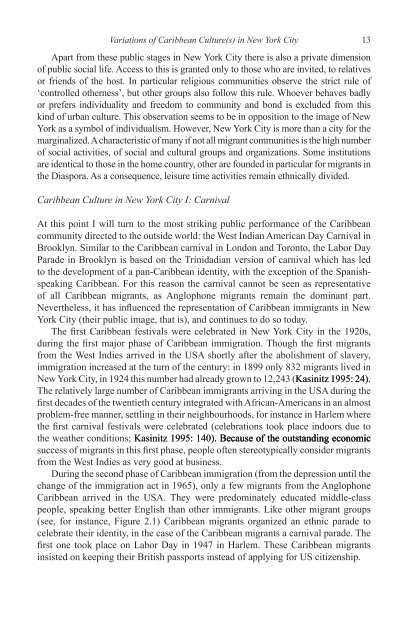Create successful ePaper yourself
Turn your PDF publications into a flip-book with our unique Google optimized e-Paper software.
Variations <strong>of</strong> <strong>Caribbean</strong> Culture(s) <strong>in</strong> <strong>New</strong> <strong>York</strong> <strong>City</strong> 13<br />
Apart from <strong>the</strong>se public stages <strong>in</strong> <strong>New</strong> <strong>York</strong> <strong>City</strong> <strong>the</strong>re is also a private dimension<br />
<strong>of</strong> public social life. Access to this is granted only to those who are <strong>in</strong>vited, to relatives<br />
or friends <strong>of</strong> <strong>the</strong> host. In particular religious communities observe <strong>the</strong> strict rule <strong>of</strong><br />
‘controlled o<strong>the</strong>rness’, but o<strong>the</strong>r groups also follow this rule. Whoever behaves badly<br />
or prefers <strong>in</strong>dividuality and freedom to community and bond is excluded from this<br />
k<strong>in</strong>d <strong>of</strong> urban culture. This observation seems to be <strong>in</strong> opposition to <strong>the</strong> image <strong>of</strong> <strong>New</strong><br />
<strong>York</strong> as a symbol <strong>of</strong> <strong>in</strong>dividualism. However, <strong>New</strong> <strong>York</strong> <strong>City</strong> is more than a city for <strong>the</strong><br />
marg<strong>in</strong>alized. A characteristic <strong>of</strong> many if not all migrant communities is <strong>the</strong> high number<br />
<strong>of</strong> social activities, <strong>of</strong> social and cultural groups and organizations. Some <strong>in</strong>stitutions<br />
are identical to those <strong>in</strong> <strong>the</strong> home country, o<strong>the</strong>r are founded <strong>in</strong> particular for migrants <strong>in</strong><br />
<strong>the</strong> <strong>Diaspora</strong>. As a consequence, leisure time activities rema<strong>in</strong> ethnically divided.<br />
<strong>Caribbean</strong> Culture <strong>in</strong> <strong>New</strong> <strong>York</strong> <strong>City</strong> I: Carnival<br />
At this po<strong>in</strong>t I will turn to <strong>the</strong> most strik<strong>in</strong>g public performance <strong>of</strong> <strong>the</strong> <strong>Caribbean</strong><br />
community directed to <strong>the</strong> outside world: <strong>the</strong> West Indian American Day Carnival <strong>in</strong><br />
Brooklyn. Similar to <strong>the</strong> <strong>Caribbean</strong> carnival <strong>in</strong> London and Toronto, <strong>the</strong> Labor Day<br />
Parade <strong>in</strong> Brooklyn is based on <strong>the</strong> Tr<strong>in</strong>idadian version <strong>of</strong> carnival which has led<br />
to <strong>the</strong> development <strong>of</strong> a pan-<strong>Caribbean</strong> identity, with <strong>the</strong> exception <strong>of</strong> <strong>the</strong> Spanishspeak<strong>in</strong>g<br />
<strong>Caribbean</strong>. For this reason <strong>the</strong> carnival cannot be seen as representative<br />
<strong>of</strong> all <strong>Caribbean</strong> migrants, as Anglophone migrants rema<strong>in</strong> <strong>the</strong> dom<strong>in</strong>ant part.<br />
Never<strong>the</strong>less, it has <strong>in</strong>fluenced <strong>the</strong> representation <strong>of</strong> <strong>Caribbean</strong> immigrants <strong>in</strong> <strong>New</strong><br />
<strong>York</strong> <strong>City</strong> (<strong>the</strong>ir public image, that is), and cont<strong>in</strong>ues to do so today.<br />
The first <strong>Caribbean</strong> festivals were celebrated <strong>in</strong> <strong>New</strong> <strong>York</strong> <strong>City</strong> <strong>in</strong> <strong>the</strong> 1920s,<br />
dur<strong>in</strong>g <strong>the</strong> first major phase <strong>of</strong> <strong>Caribbean</strong> immigration. Though <strong>the</strong> first migrants<br />
from <strong>the</strong> West Indies arrived <strong>in</strong> <strong>the</strong> <strong>USA</strong> shortly after <strong>the</strong> abolishment <strong>of</strong> slavery,<br />
immigration <strong>in</strong>creased at <strong>the</strong> turn <strong>of</strong> <strong>the</strong> century: <strong>in</strong> 1899 only 832 migrants lived <strong>in</strong><br />
<strong>New</strong> <strong>York</strong> <strong>City</strong>, <strong>in</strong> 1924 this number had already grown to 12,243 (Kas<strong>in</strong>itz 1995: 24).<br />
The relatively large number <strong>of</strong> <strong>Caribbean</strong> immigrants arriv<strong>in</strong>g <strong>in</strong> <strong>the</strong> <strong>USA</strong> dur<strong>in</strong>g <strong>the</strong><br />
first decades <strong>of</strong> <strong>the</strong> twentieth century <strong>in</strong>tegrated with African-Americans <strong>in</strong> an almost<br />
problem-free manner, settl<strong>in</strong>g <strong>in</strong> <strong>the</strong>ir neighbourhoods, for <strong>in</strong>stance <strong>in</strong> Harlem where<br />
<strong>the</strong> first carnival festivals were celebrated (celebrations took place <strong>in</strong>doors due to<br />
<strong>the</strong> wea<strong>the</strong>r conditions; Kas<strong>in</strong>itz 1995: 140). Because <strong>of</strong> <strong>the</strong> outstand<strong>in</strong>g economic<br />
success <strong>of</strong> migrants <strong>in</strong> this first phase, people <strong>of</strong>ten stereotypically consider migrants<br />
from <strong>the</strong> West Indies as very good at bus<strong>in</strong>ess.<br />
Dur<strong>in</strong>g <strong>the</strong> second phase <strong>of</strong> <strong>Caribbean</strong> immigration (from <strong>the</strong> depression until <strong>the</strong><br />
change <strong>of</strong> <strong>the</strong> immigration act <strong>in</strong> 1965), only a few migrants from <strong>the</strong> Anglophone<br />
<strong>Caribbean</strong> arrived <strong>in</strong> <strong>the</strong> <strong>USA</strong>. They were predom<strong>in</strong>ately educated middle-class<br />
people, speak<strong>in</strong>g better English than o<strong>the</strong>r immigrants. Like o<strong>the</strong>r migrant groups<br />
(see, for <strong>in</strong>stance, Figure 2.1) <strong>Caribbean</strong> migrants organized an ethnic parade to<br />
celebrate <strong>the</strong>ir identity, <strong>in</strong> <strong>the</strong> case <strong>of</strong> <strong>the</strong> <strong>Caribbean</strong> migrants a carnival parade. The<br />
first one took place on Labor Day <strong>in</strong> 1947 <strong>in</strong> Harlem. These <strong>Caribbean</strong> migrants<br />
<strong>in</strong>sisted on keep<strong>in</strong>g <strong>the</strong>ir British passports <strong>in</strong>stead <strong>of</strong> apply<strong>in</strong>g for US citizenship.


















